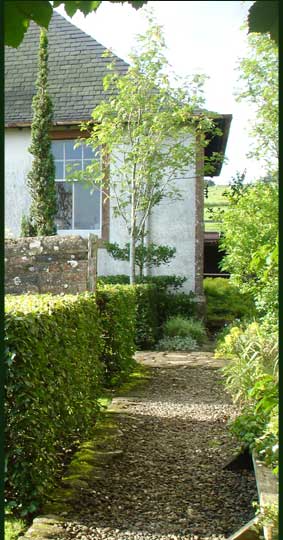



























The Alchemillas are in full flower for at least seven weeks from late June through to mid August.
The garden rises up hill behind the house like my favourite gardens at St Catherine's Court, Clevedon Court, and Harold Peto's garden at Iford Manor, all in my native Somerset.
I cut the existing beech hedge down to open up the views over the valley of the River Medwin, and planted more hedges around the lawn to give it shape.
In the back garden I cut beds out of the playground. I salvaged an Alchemilla from the rock garden and divided it, and filled the first bed. As I cut out more beds each year so I lifted the plants and divided them again and again until the whole playground was covered, except for a narrow path leading through to the summerhouse.
Charles Platt's book, Italian Gardens, was given to me by two kind American ladies, a mother and daughter, who came to spend a summer's day with me in my garden. They had been all round Europe, studying gardens large and small, and the daughter hoped to lay out some original and typical gardens in America that would be suitable to the soil and the climate; also to try and preserve the beautiful flora of that country, which is in danger of dying away.
Maria Theresa Earle, Pot-Pourri From a Surrey Garden, 1897
Mrs Earle's young visitor, the landscape architect Beatrix Farrand (1872-1959), seems to have realised early in her career, that the great Italian gardens were planted with native Italian plants, and to have decided that by combining Italian design with American native plants she would create a distinctly American garden. I have adopted the same approach here where only the hardiest native British trees will thrive and look luxuriant. On a warm, sunny day it is something like a small corner of an old Italian garden.
There was no garden here when we came, except a rock garden. I dismantled it and used the stone to create the patio on the same spot, and put the plants in around it.
Graeme Moore makes gardens simply by cutting grass at different levels. These he calls 'Herbe Gardens', borrowing the French for grass. He dispenses with flowerbeds and borders, ornaments, paths, walls and statuary, indeed all those elements which we now look on as essential to garden-making. Instead, he makes a deeply satisfying garden by articulating the grass into patterns of long and short areas forming circles and squares, axes and cross-axes, sometimes even mowing bold serpentine baroque rhythms. In this he echoes, in late twentieth-century terms, voices from the past, for until the plant explosion of the Victorian age, descriptions of some of the most admired gardens never even refer to flowers at all.
Sir Roy Strong, 2000

Graeme Moore trained in horticulture at Cannington College, Somerset and Writtle College, Essex, and studied art history and literature at the University of Essex. Following early experience in the gardens on Garinish Island, Co Cork, designed by Harold Peto, he developed an interest in houses and gardens of the 1890s and early 1900s. He lectures and writes about their designers and the people who employed them, and their conservation and management.
After the stiff climb to the top of the garden I have placed a seat looking back over a box circle planted with pansies and beyond it to the extension to the house, which was designed by the Glasgow architect, Lachlan Munro.






Graeme can be contacted at info@graememoore.com
View the current online exhibition:
"The New Orangery (1983) Dumbarton Oaks, and other early works"
On the lawn in the front garden I made a cut-grass garden and beyond it I erected a Homebase 'Baronet' greenhouse to form a focal point.
Nice... very nice...
Ian Hamilton Finlay, July 2000
A serpentine path back down the hill recalls William Hogarth's Line of Beauty and his writings on simplicity and variety.
The hedge is Field Maple, cut in the style of the great Italian architect Carlo Scarpa, with a balcony at one end forming a Claire Voie, and a staircase at the other.